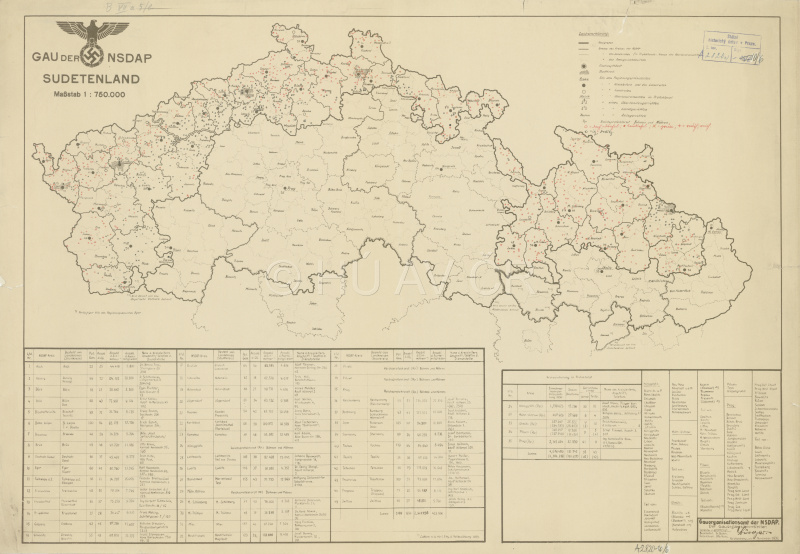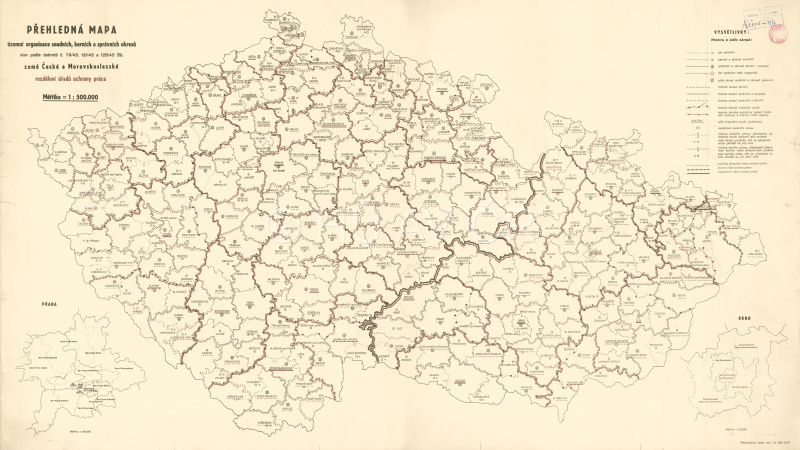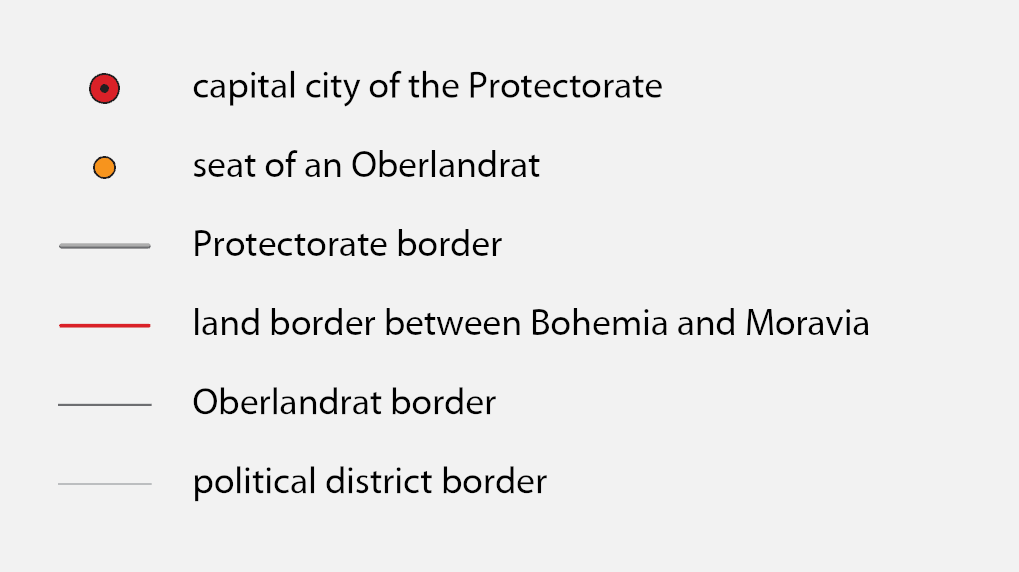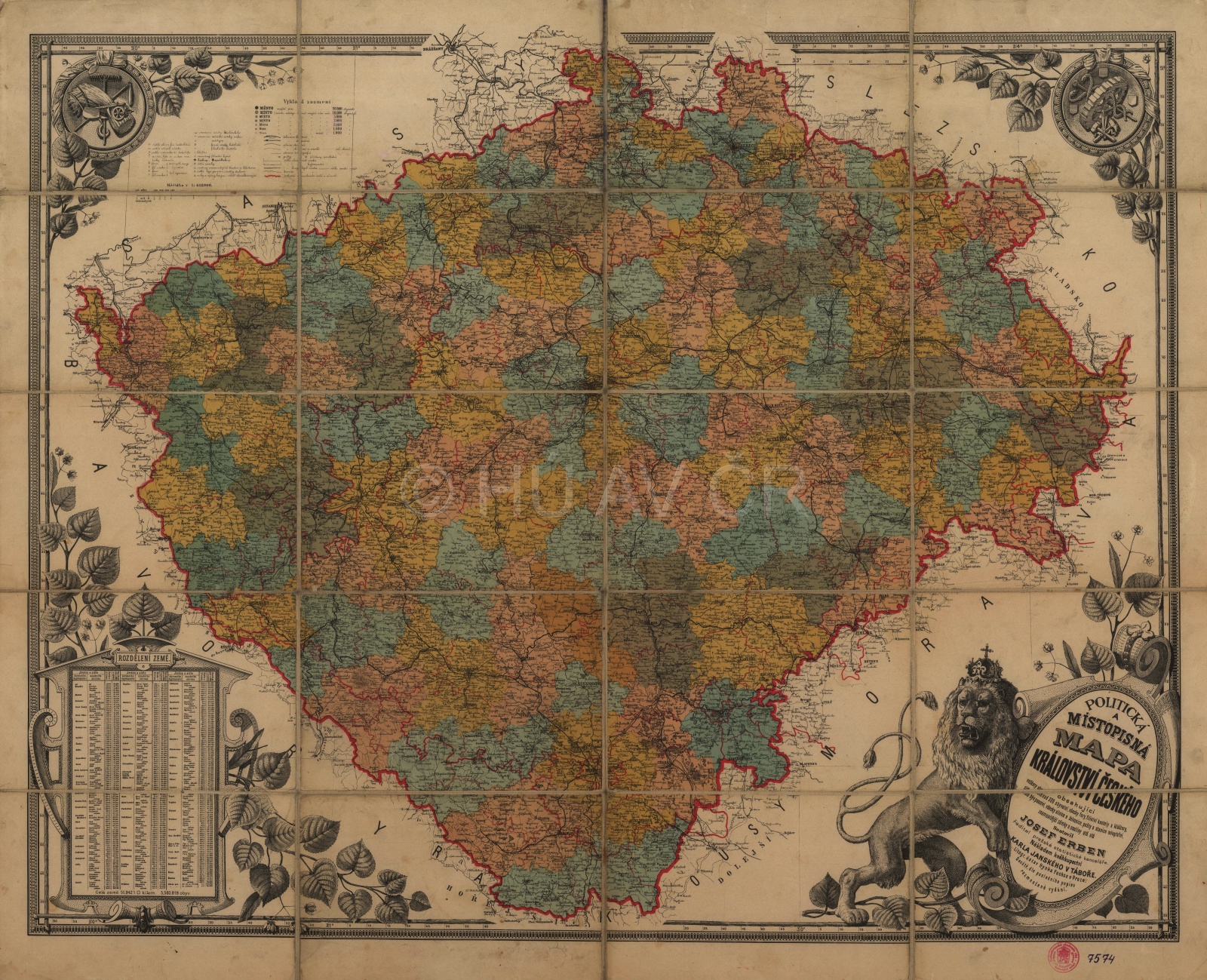Administrative structure in 1939–1940
New administrative units were established in areas ceded to Germany, in particular the so-called Sudeten County from Domažlice to Moravská Ostrava with the capital in Liberec. The territory in the south of Bohemia and Moravia was attached to the existing territorial units (the Bayern, Nieder and Ober Donau counties) with several new administrative capitals. The Hlučín region was again connected with Prussia and incorporated into the Silesia province. There were two administrative systems in the Protectorate: the Protectorate administration under direct and indirect administration of the Germans and the German Reich administration, which established the so-called supervision districts – Oberlandrat – according to the German Reich model. The supreme authority of the Reich Commissariat was the Reichsprotektor and in 1942, the German minister of state for Bohemia and Moravia became the supreme occupational authority headed by the Reich Minister Karl Hermann Frank based in Prague.
The original number of 35 Oberlandräte from 1939 (23 in Bohemia and 12 in Moravia) was reduced in 1939 to 20, in 1941 to 15 and in 1942 to only 7 (Praha, Brno, České Budějovice, Hradec Králové, Jihlava, Olomouc and Plzeň). The most radical change took place on 15 June 1942 when, within the so-called Heydrich administrative reform, a large part of the administration was transferred to autonomous Protectorate organs (staffed by the Germans) and the Oberlandräte only retained the political and supervisory functions. The Bohemian-Moravian administrative border changed and the administrative authorities were reduced to 67 political districts (44 in Bohemia and 23 in Moravia) and 186 judicial districts (125 in Bohemia and 61 in Moravia). In 1944, the Prague Oberlandrat was reduced and its status was changed to town with a special status.

In the spring of 1939, the new county of Reichsgau Sudetengau was established on a large part of territory that was ceded to Germany after the Munich Agreement. Map Collection of the Institute of History, CAS. Display map
References
Hledíková, Z. – Janák, J. – Dobeš J.: Dějiny správy v českých zemích: od počátků státu po současnost. Praha 2005, dotisk 2011;
Kocourek, L.: Správa v českých zemích a v Československu v letech 1848–2005. Praha 2007;
Schelle, K. – Tauchen, J.: Recht und Verwaltung im Protektorat Böhmen und Mähren. München 2009;
Semotanová, E. – Cajthaml, J. a kol.: Akademický atlas českých dějin. Praha 1914, 2. akt. vydání 2016;
Semotanová, E. Zudová-Lešková, Z. ‒ Močičková, J. Cajthaml, J. ‒ Seemann, P. ‒ Bláha J. D. a kol.: Český historický atlas. Kapitoly z dějin 20. století. Praha 2019.

This work is licensed under a Creative Commons BY-NC-ND 4.0
Administrative structure in 1940–1942
New administrative units were established in areas ceded to Germany, in particular the so-called Sudeten County from Domažlice to Moravská Ostrava with the capital in Liberec. The territory in the south of Bohemia and Moravia was attached to the existing territorial units (the Bayern, Nieder and Ober Donau counties) with several new administrative capitals. The Hlučín region was again connected with Prussia and incorporated into the Silesia province. There were two administrative systems in the Protectorate: the Protectorate administration under direct and indirect administration of the Germans and the German Reich administration, which established the so-called supervision districts – Oberlandrat – according to the German Reich model. The supreme authority of the Reich Commissariat was the Reichsprotektor and in 1942, the German minister of state for Bohemia and Moravia became the supreme occupational authority headed by the Reich Minister Karl Hermann Frank based in Prague.
The original number of 35 Oberlandräte from 1939 (23 in Bohemia and 12 in Moravia) was reduced in 1939 to 20, in 1941 to 15 and in 1942 to only 7 (Praha, Brno, České Budějovice, Hradec Králové, Jihlava, Olomouc and Plzeň). The most radical change took place on 15 June 1942 when, within the so-called Heydrich administrative reform, a large part of the administration was transferred to autonomous Protectorate organs (staffed by the Germans) and the Oberlandräte only retained the political and supervisory functions. The Bohemian-Moravian administrative border changed and the administrative authorities were reduced to 67 political districts (44 in Bohemia and 23 in Moravia) and 186 judicial districts (125 in Bohemia and 61 in Moravia). In 1944, the Prague Oberlandrat was reduced and its status was changed to town with a special status.

Administrative map of the Protectorate since 15th June 1942. Map Collection of the Institute of History, CAS. Display map
References
Hledíková, Z. – Janák, J. – Dobeš J.: Dějiny správy v českých zemích: od počátků státu po současnost. Praha 2005, dotisk 2011;
Kocourek, L.: Správa v českých zemích a v Československu v letech 1848–2005. Praha 2007;
Schelle, K. – Tauchen, J.: Recht und Verwaltung im Protektorat Böhmen und Mähren. München 2009;
Semotanová, E. – Cajthaml, J. a kol.: Akademický atlas českých dějin. Praha 1914, 2. akt. vydání 2016;
Semotanová, E. Zudová-Lešková, Z. ‒ Močičková, J. Cajthaml, J. ‒ Seemann, P. ‒ Bláha J. D. a kol.: Český historický atlas. Kapitoly z dějin 20. století. Praha 2019.

This work is licensed under a Creative Commons BY-NC-ND 4.0
Administrative structure since 1942
New administrative units were established in areas ceded to Germany, in particular the so-called Sudeten County from Domažlice to Moravská Ostrava with the capital in Liberec. The territory in the south of Bohemia and Moravia was attached to the existing territorial units (the Bayern, Nieder and Ober Donau counties) with several new administrative capitals. The Hlučín region was again connected with Prussia and incorporated into the Silesia province. There were two administrative systems in the Protectorate: the Protectorate administration under direct and indirect administration of the Germans and the German Reich administration, which established the so-called supervision districts – Oberlandrat – according to the German Reich model. The supreme authority of the Reich Commissariat was the Reichsprotektor and in 1942, the German minister of state for Bohemia and Moravia became the supreme occupational authority headed by the Reich Minister Karl Hermann Frank based in Prague.
The original number of 35 Oberlandräte from 1939 (23 in Bohemia and 12 in Moravia) was reduced in 1939 to 20, in 1941 to 15 and in 1942 to only 7 (Praha, Brno, České Budějovice, Hradec Králové, Jihlava, Olomouc and Plzeň). The most radical change took place on 15 June 1942 when, within the so-called Heydrich administrative reform, a large part of the administration was transferred to autonomous Protectorate organs (staffed by the Germans) and the Oberlandräte only retained the political and supervisory functions. The Bohemian-Moravian administrative border changed and the administrative authorities were reduced to 67 political districts (44 in Bohemia and 23 in Moravia) and 186 judicial districts (125 in Bohemia and 61 in Moravia). In 1944, the Prague Oberlandrat was reduced and its status was changed to town with a special status.

The administration was fully restored to the condition of 30 September 1938 in November 1945. However, some changes occurred in areas where the German population was relocated. Map Collection of the Institute of History, CAS. Display map
References
Hledíková, Z. – Janák, J. – Dobeš J.: Dějiny správy v českých zemích: od počátků státu po současnost. Praha 2005, dotisk 2011;
Kocourek, L.: Správa v českých zemích a v Československu v letech 1848–2005. Praha 2007;
Schelle, K. – Tauchen, J.: Recht und Verwaltung im Protektorat Böhmen und Mähren. München 2009;
Semotanová, E. – Cajthaml, J. a kol.: Akademický atlas českých dějin. Praha 1914, 2. akt. vydání 2016;
Semotanová, E. Zudová-Lešková, Z. ‒ Močičková, J. Cajthaml, J. ‒ Seemann, P. ‒ Bláha J. D. a kol.: Český historický atlas. Kapitoly z dějin 20. století. Praha 2019.

This work is licensed under a Creative Commons BY-NC-ND 4.0

